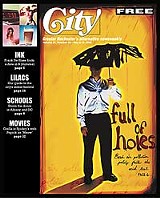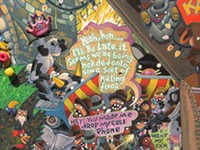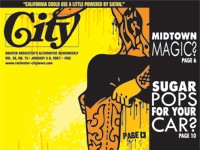[
{
"name": "500x250 Ad",
"insertPoint": "5",
"component": "15667920",
"parentWrapperClass": "",
"requiredCountToDisplay": "1"
}
]
Now that spring is breaking out, what’s not to love about “Clear Skies”? One thing, maybe: George W. Bush has
slapped the term on his latest attempt to sell Americans on “market-based”
environmental cleanup and the virtues of fossil fuels.
Nothing new here for Bush; he let
oil and markets rule the big skies of Texas. Now with his federal initiative
--- aimed at retooling the Clean Air Act and its regulatory style --- he’s
sending clouds over New York and its environmental movement.
Bush trumpeted
Clear
Skies on Earth Day, April 22, in the Adirondack town of Wilmington. The choice
of stage helped George Pataki’s act during a gubernatorial election year, but
Bush sought wider political gains by focusing on a regional scourge: acid rain.
At first blush, Clear Skies sounds
ambitious and comprehensive. A White House backgrounder says the approach will
“replace a cycle of endless litigation with rapid and certain improvements in
air quality.
As Bush outlined it, the initiative
would:
• cut sulfur dioxide emissions 73
percent, to 3 million tons in 2018;
• cut nitrogen oxide emissions 67
percent, to 1.7 million tons in 2018;
• cut mercury emissions 69 percent,
to 15 tons in 2018;
• cut “greenhouse gas intensity” by
18 percent over the next decade.
Several things pop out. First,
there’s the recurrent date 2018, suggesting that Clear Skies actually means Go
Slow. Then there’s stealth language like “greenhouse gas intensity,” i.e. the
ratio of greenhouse gas output to GDP. Attacking intensity as opposed to absolute
levels of greenhouse gases could have a perverse effect. Thus a recent Pew
Center on Global Climate Change report says Bush’s “18 percent reduction in
emissions intensity between now and 2012 will allow actual
emissions to increase 12 percent over the same period.”
Bush also proposes to replace direct
controls --- for example, forcing the installation of anti-pollution equipment
--- with “cap-and-trade,” a.k.a. “pollution trading.” Cap-and-trade would allow
the operator of a dirty plant to buy unused credits from the operator of a
cleaner plant. Such deal-making might lead to lower emissions overall. But by allowing a dirty plant
to keep on polluting, cap-and-trade can harm local environments and
populations.
Moreover, Bush’s Clear Skies would
relax some current standards. Take one of the worst: mercury, a pollutant that
affects the nervous system and is especially harmful to fetuses and young
children. A Sierra Club rebuttal to Clear Skies notes that under current law
and regulations, mercury emissions could be cut “to between five and 15 tons by
2008, as much as a 90 percent reduction per plant.” By contrast, says the Club,
Bush would cut mercury emissions by only half as much, and take longer to do
it.
There’s also a big hidden
agenda-item: Bush is making a sneak attack on “New Source Review” or NSR, a
powerful regulatory anti-pollution device.
In line with the 1970 Clean Air Act
and later amendments, NSR was aimed at phasing out old dirty power plants. It’s
supposed to work like this: When an old plant is “retired” or changed over to
new technology, the new facility must conform to the latest standards. NSR does
allow for routine maintenance.
But what’s routine and what’s not?
Some environmentalists and regulators charge that utilities sometimes do major
renovations under the guise of “maintenance and repair.” For example, earlier
this year, New York State Attorney General Eliot Spitzer filed suit against
Niagara Mohawk (NiMo) and NRG Energy Inc., charging their Dunkirk and Huntley
coal-fired power plants in Western New York were violating the Clean Air Act by
exceeding current emissions limits. (The plants, which NiMo owned and operated
for years, were sold to NRG in 1999.)
According to Spitzer’s news release,
NiMo carried out “major modifications at the power plants,” including the
replacement of a turbine and an upgrade of a boiler. These modifications, said
Spitzer, triggered New Source Review; thus NiMo and NRG Energy should have
brought the plants into compliance with the new regs, or shut them down. (An
NRG spokesperson supplied us a written statement from the company. NRG, says
the statement, “has been working diligently” with NiMo and state regulators
toward an out-of-court solution.)
For similar reasons, Spitzer has
taken legal action against Rochester Gas and Electric’s Russell Station, a
coal-fired plant in Greece. Russell Station is a small plant and does not
contribute much pollution, says RG&E spokesperson Mike Power. He adds
RG&E has done only routine maintenance at Russell and therefore has not
stepped over the regulatory line. In any case, says Power, RG&E is still in
discussions with Spitzer’s office.
What will be Russell’s future? Will
it close? Will it be made cleaner? Power says it could be converted to
low-sulfur coal or refitted with catalytic devices to remove oxides of
nitrogen, etc.
Oddly or
shrewdly,
the new White House initiative doesn’t dwell on NSR.
Bush allies have been explicit and
thorough on this point, however. In a recent New York Times op-ed, for example, A. Denny Ellerman and Paul L.
Joskow of MIT’s Center for Energy and Environmental Policy Research launch a
full-frontal assault on NSR. The concept, say Ellerman and Joskow, is “an
outdated and obstructive feature of the Clean Air Act” that “never made much
sense.” They fall back on a market syllogism: It’s difficult and expensive to
build new plants. It’s relatively easy and cheap to maintain and upgrade old
ones. Therefore, the electric utilities are prone to keep the old plants up and
running. And that inclination, it is suggested, should be our command.
But all that aside, Bush did well to
focus international attention on the Adirondacks.
The region’s 2,000-plus lakes and
ponds are especially vulnerable. The region is downwind from industrial
pollution sources --- including old fossil fuel plants in the Ohio Valley and
Great Lakes region (like the Huntley and Dunkirk plants) that were “grandfathered”
by federal law. And Adirondack soils and bedrock don’t have the alkaline
“buffers” which chemically neutralize the acidity.
The problem is as widespread as it
is severe. Studies done for the New York State Department of Environmental
Conservation in the 1980s found that 25 percent of Adirondack lakes and ponds
were heavily affected, and that almost half were at great risk. Anti-pollution
efforts have changed the data for certain pollutants --- but Adirondack waters
are still in mortal danger.
Still, as Bush spoke in the shadow
of Whiteface Mountain, he widened a chasm in the statewide environmental
movement.
On one side of this chasm is the
Adirondack Council, which stood with Bush at the Whiteface photo-op. (Also on
this side are the Nature Conservancy and the Student Conservation Association,
both of which Bush thanked in his remarks, plus some other fishing and hunting
organizations.)
Council spokesperson John Sheehan
justifies his group’s support. Clear Skies, he says, “has the fastest cuts,
it’s the least expensive, and it’s way to get the Midwestern plants to agree.”
The initiative, he says, is very close to a bill the Council supported in the
mid-1990s, one drafted by Senator Daniel P. Moynihan.
But is consorting with Bush a political problem for the environmental
movement? Sheehan turns the question around. Some national groups, he charges,
are reflexively anti-Bush and will avoid doing anything that gives the man
credit. “Asking for ‘perfect’ is a good way to get nothing,” says Sheehan. It’s
“gratifying” that someone is doing
something in Washington, he says.
Things look different over at the
Sierra Club --- one of the groups Sheehan criticizes.
“Their approach,” says Albany-based
Sierra Club spokesperson John Stouffer, referring to the Adirondack Council and
friends, “seems to be to move to the lowest common denominator to pass something.”
Stouffer reserves his harshest
criticisms for Clear Skies, though. He acknowledges the Bush proposal mirrors
the old Moynihan bill; but both, he says, “would step up reductions very
slowly.” The problem, says Stouffer, is that the Moynihan bill, now almost a
decade old, is based on a now-obsolete understanding of the air-quality
problems we face.
Nor is the Sierra Club isolated on
this issue, according to Stouffer. Allied groups, he says, include
Environmental Advocates, the Natural Resources Defense Council, the League of
Conservation Voters, the New York Public Interest Research Group (NYPIRG), the
Adirondack Mountain Club, and the American Lung Association.
This coalition is pushing a bill by
US Senator Jim Jeffords (Independent-Vermont) as an alternative to Bush. The
Jeffords bill, S.556, would mandate deeper reductions in sulfur and nitrogen
compounds. Most important, it also would cut carbon dioxide emissions --- a
greenhouse gas the Bush plan conspicuously underplays.
The American
Lung Association is a stand-out on this issue; its involvement backs up John
Stouffer’s reminder that clean air policies are about “public health threats”
as well as acidified lakes.
With Environmental Advocates and
NYPIRG, the Lung Association issued a report in 1999 that detailed the
problems. Dirty Power on the Rise in New
York says this state “has the dubious distinction of having some of the
most unhealthful air to breathe in the nation.” The New York City area is worst
off. But smog and ground-level ozone are troublesome statewide, as is
“particulate matter” pollution from fossil-fuel power plants and diesel trucks
and buses.
Many studies, says the report, “have
linked particulate pollution with premature death… aggravation of asthma, and
decreased lung function… In New York State alone, over 3,000 lives are cut
short each year due to fine particulates.” The report draws special attention
to mercury. “Benefiting from the Clean Air Act loophole, New York’s 21 dirtiest
power plants released over 2,000 pounds of mercury between 1995 and 1997,” it
says.
RG&E’s Russell Station is on the
list of 21. Its sulfur dioxide emissions, to cite one category, are around
one-third those of the Huntley plant --- but still nothing to sniff at. And
don’t forget, we’re downwind of the Dunkirk and Huntley plants, and lots more
like them in the Midwest.










